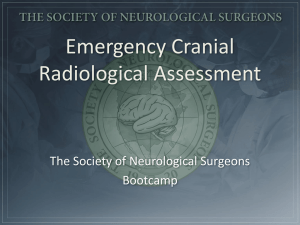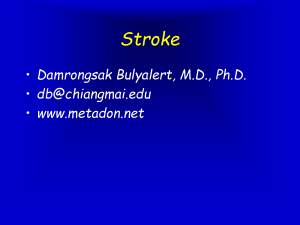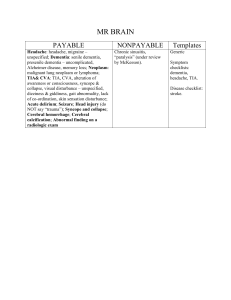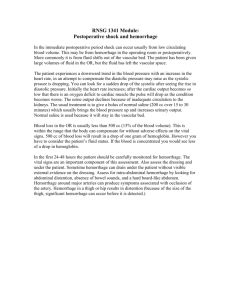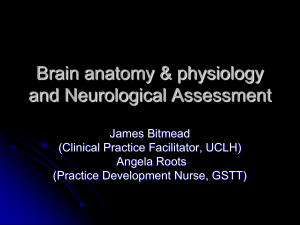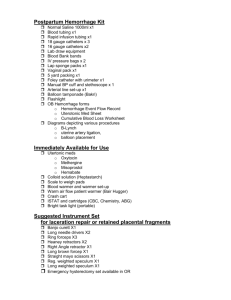Neurosurgery
advertisement
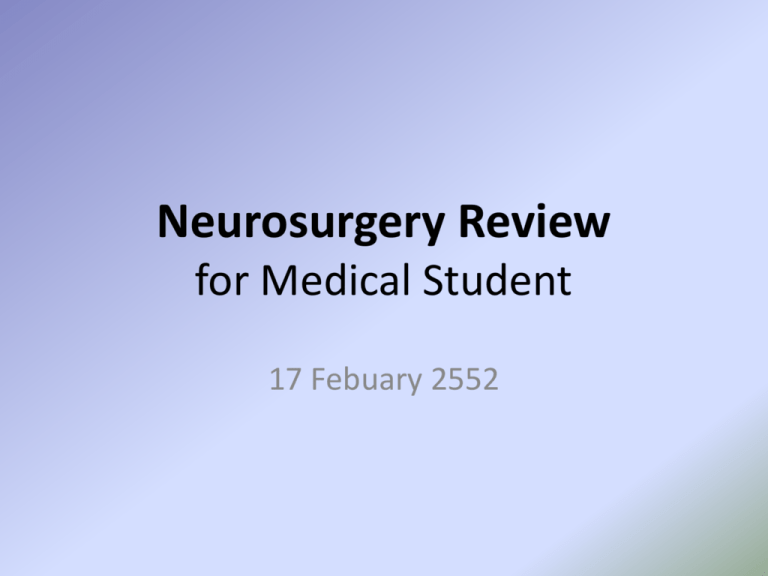
Neurosurgery Review for Medical Student 17 Febuary 2552 Stroke • ผู้ป่วยหญิงอายุ 50 ปี ขณะดูโทรทัศน์ที่โซฟา มีอาการปวดท้ ายทอย อย่างมาก อาเจียน ซึมลง PE : GCS 13, no motor weakness, stiff neck +ve จงให้ การวินิจฉัย a) b) c) d) e) Pontine hemorrhage Cellebellar hemorrhage Subarchnoid hemorrhage Basal ganglion hemorrhage Intraventricular hemorrhage เฉลย C Stroke • Ischemic VS hemorrhagic • Ischemic syndrome ต่าง ๆ • Hemorrhagic disease – Hypertensive hemorrhage – Amyloid angiopathy – SAH from ruptured aneurysm – Ruptured AVM – (อื่น ๆ – bleeding tumor, coagulopathy, parasite, vasculitis) Stroke • Ischemic VS hemorrhagic – Hemorrhagic stroke มักมี sign of IICP (ปวดหัว อาเจียน ซึม ลง) – Ischemic stroke มักมาด้ วย sudden neurodeficit • Hemiparesis • Apasia / apraxia • Amaurosis fugax – Onset แยกไม่ได้ – Clinical แยกไม่ได้ 100% need investigation = CT Stroke • Ischemic stroke – MCA: Hemiparesis, contralateral hemisensory loss, aphasia – ACA: Paresis and sensory loss of contralateral lower extremity – PCA: Homonymous hemianopia with macular sparing – Basilar: Cranial nerve signs – diplopia, facial weakness, vertigo, dysarthria Stroke • Hemorrhagic stroke – Hypertensive ICH – Ruptured cerebral aneurysm – Ruptured AVM – Amyloid angiopathy – Bleeding tumor – Coagulopathy Stroke • Hypertensive ICH – Hypertension > 90% – IICP signs and symptoms (headache, vomiting, ↓consciousness) – Common site: • Basal ganglion – Hemiparesis, Aphasia (dominant hemisphere) • Thalamus – hemianesthesia • Cerebellar – ataxia, cerebellar sign +ve • Pontine – pinpoint pupil Stroke • Hypertensive ICH – Antihypertensive drugs • SBP > 200 IV antihypertensive • SBP > 180 or MAP > 130 – IICP suspected monitor ICP keep CPP 60-80 mmHg – No IICP suspected modest ↓ BP to MAP 110 or 160/90 – Surgery VS Medical treatment • Recommendation: cerebellar hemorrhage > 3 cm (class I) AHA guideline 2007 Stroke • Ruptured cerebral aneurysm – “Worst headache of my life” – With or without neurodeficit – Stiffneck / nuchal rigidity – CT: Subarachnoid hemorrhage – Common sequelae: • Rebleeding • Hydrocephalus • Vasospasm Stroke • Ruptured cerebral aneurysm – Key point of management • Refer to neurosurgeon ASAP (for clipping to prevent rebleeding) • If clinical suspected but negative CT LP ดู xanthochromia • Investigation of choice: 4 vessels angiography (alternative: CT angiography (CTA), MRA) Stroke • Ruptured AVM – Young age** – Lobar hemorrhage – Non-hypertension – Investigation: angiography – Risk rebleeding 2-3%/y – Management: • Surgery – excision • Embolization • Radiosurgery Stroke • Investigation in intracerebral hemorrhage • Consider – Angiography – CT angiography In – Young age (< 45) – Non hypertension – Uncommon site (Lobar) Stroke • Amyloid angiopathy – Old age – Non-hypertension – Lobar hemorrhage – No special investigation needed Trauma • ผู้ป่วยชายอายุ 50 ปี ขับรถยนต์ชนจักรยานยนต์ สลบไป 10 นาที ตื่นมารู้เรื่ องดี หน่วยกู้ภยั นาส่งรพ. ตรวจร่างกายแรกรับปกติ อีก 2 ชัว่ โมงซึมลง GCS E1V2M5, pupils right 3 mm, left 5 mm SRTL คิดถึงภาวะใดมากที่สดุ a) b) c) d) e) Epidural hemorrhage Subdural hemorrhage Subarachnoid hemorrhage Intracerebral hemorrhage Diffuse axonal injury เฉลย a Trauma • • • • • • • Initial management* Epidural hematoma* Subdural hematoma* Traumatic intracerebral hematoma Traumatic SAH Skull fracture Sequalae Trauma • Initial management – ABCDE – Don’t miss! • Collar (primary survey = A) • ET tube in GCS ≤ 8 (primary survey = D) • Search for other bleeding site in hypotensive patient – GCS (Must remember!) Trauma โจทย์ short essay: moderate HI in rural hospital Item GCS C-spine protection O2 IV Refer or CT brain Suture/dressing Dilantin Foley or NG ตอบถูก 47 14 17 47 50 37 11 20 % 71.21 21.21 25.76 71.21 75.76 56.06 16.67 30.30 Trauma Glassow Coma scale Eye Verbal Motor ทาตามสัง่ ได้ Score 6 ปกติ ปั ดที่บริเวณเจ็บได้ 5 ลืมตาเอง พูดเป็ นประโยค แต่สบั สน Withdraws 4 ลืมตาเมื่อเจ็บ ลืมตาเมื่อเรี ยก พูดเป็ นคามีความหมาย ส่งเสียงอืออา 3 2 ไม่ลืมตา ไม่มีเสียง Decorticate Decerebrate ไม่มีการเคลื่อนไหว 1 การดูแลผู้ป่วย Head Injury GCS 13-15 Mild HI ประเมิน risk Mild HI 1. D/C 2. Admit observe 3. CT ABCDEs, C spine protection Resuscitation ประเมิน GCS GCS 9-12 Moderate HI GCS < 9 Severe HI พิจารณา O2 mask c bag IV fluid พิจารณา Endotracheal tube Hyperventilation ** Mannitol/osmolar Rx ** Refer Trauma Risk factors for Intracranial lesion for Mild HI • Clinical findings – – – – – – GCS < 15 หลัง 1-2 ชั่วโมง* Amnesia ปวดศีรษะ อาเจียน มีประวัติหมดสติ มี Sign ของกะโหลกแตก (skull Fx (Skull Base/Valve) – ตรวจพบความผิดปกติทางระบบ ประสาท* • Risk factors – อายุ > 60 – Coagulopathy (Warfarin, Hemophilia,etc) – ชัก* – ดื่มสุรา/ใช้ สารเสพติด – มีกลไกการบาดเจ็บที่รุนแรง เช่น โดนรถ ชนขณะเดินถนน Trauma • Epidural Hematoma (EDH) – Associated with skull fracture – Classic: Middle meningeal artery tear – Lens shape/biconvex – Lucid interval* – Rapidly fatal – Good prognosis if proper management Trauma • Subdural hematoma (SDH) – Venous tear/ brain laceration – High morbidity/mortality due to underlying brain injury – Crescent – concaved shape – Counter coup Trauma • Chronic Subdural hematoma (CSDH) – Elderly, alcohol abuse, coagulopathy – Motor oil fluid, no clot – Minimal or no Hx of injury – Insidious onset • Minor symptoms hemiplegia/seizure Trauma • Skull Fracture – Skull Fx ↑ risk of intracranial bleeding 5 times – Skull base fracture • CSF rhinorrhea, otorrhea • Battle’s sign, Raccoon’s eye (anterior skull base) • Facial weakness (petrous part of temporal bone) Trauma Sequelae of head injury – Increased intracranial pressure (> 20 mmHg) • General: sedation, analgesia, elevate head, avoid hypoxia • Ventricular drainage • Mannitol • Hyperventilation • 2nd tier – Phenobarb coma – Decompressive craniectomy Trauma Sequelae of head injury – Electrolyte imbalance – hyponatremia – Seizure • Antiepileptic drug - ↓ early seizure • Prophylaxis 7 days • I/C: GCS≤10, intracranial lesion, penetrating injury, depressed skull fracture – Carotid-cavernous fistula • • • • • Posttrauma 2-3 mo Unilateral chemosis, proptosis Bruit/thrill at the orbit Ix: angiography Management: balloon embolizaion Herniation syndrome • Central – Diencephalon tentorial – Chronic – Pupils: SRTL Fixed • Uncal** – Uncus and hippocampal gyrus over tentorium – CN III compression unilateral pupil ↑, hemiparesis – Consciousness preserved in early stages – Classic for EDH Herniation syndrome • Cingulate (subfalcine H): – asymptomatic except ACA kink, warning of impending transtentorial H. • Upward – posterior fossa mass + ventriculostomy • Tonsillar – Posterior fossa mass + LP Tumor Supratentorial • Gliomas – Astrocytoma – Oligodendrogliomas – Ependymomas • Meningiomas • Sellar and suprasellar – Pituitary adenomas – craniopharyngiomas Infratentorial • Medulloblastoma (Ped) • Cerebellar astrocytoma • Brainstem gliomas • CP angle tumor – Vestibular schwannoma (acoustic neuromas) – Meningiomas • Meningiomas Tumor • Most common brain tumor – Metastasis • Most common primary brain tumor – Astrocytoma • Most common primary brain tumor in children – Medulloblastoma Glioblastoma multiforme • Grade IV of astrocytoma • Poor prognosis. 2 yr survival 11 mo for total resection Tumor • DDx for patient with progressive hemiparesis and IICP – Supratentorial tumor (Metas, gliomas, meningioma, etc) – Brain abscess (ped. With rt to lt shunt eg TOF) • DDx for patient with bitemporal hemianopia => sellar and suprasellar tumor – Pituitary adenoma – Craniopharyngioma – Meningioma Hydrocephalous • Mechanism – Obstruction at CSF pathway: • Obstructive hydrocephalous • CSF pathway: tumor, blood, etc – Obstruction at arachnoid granulation • Communicating hydrocephalous – Overproduction: choroid plexus papilloma • Treatment – Remove etiology – Drainage • Ventriculostomy (temporary) • Shunting – VP shunt – VA shunt – Ventriculo-pleural shunt
